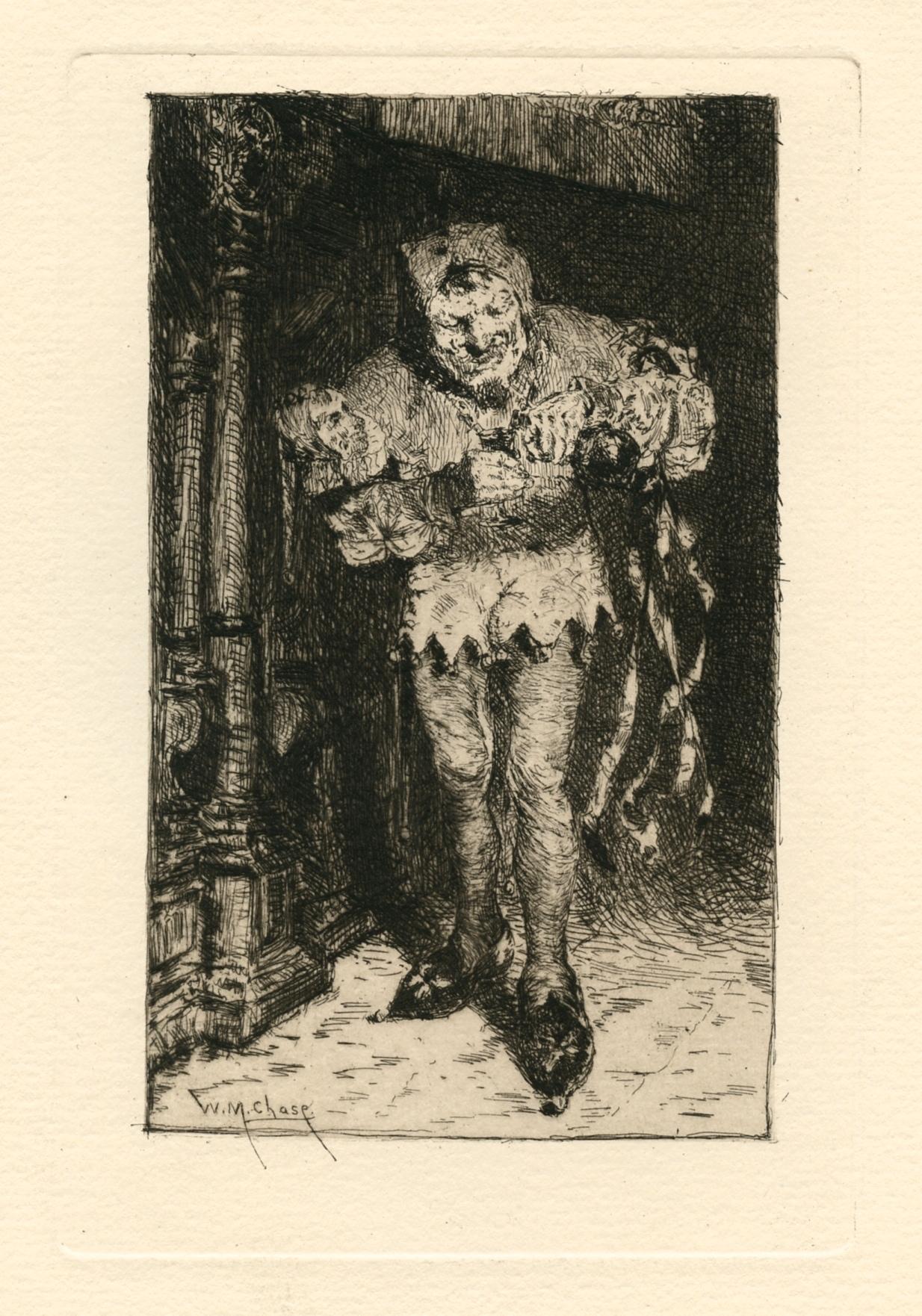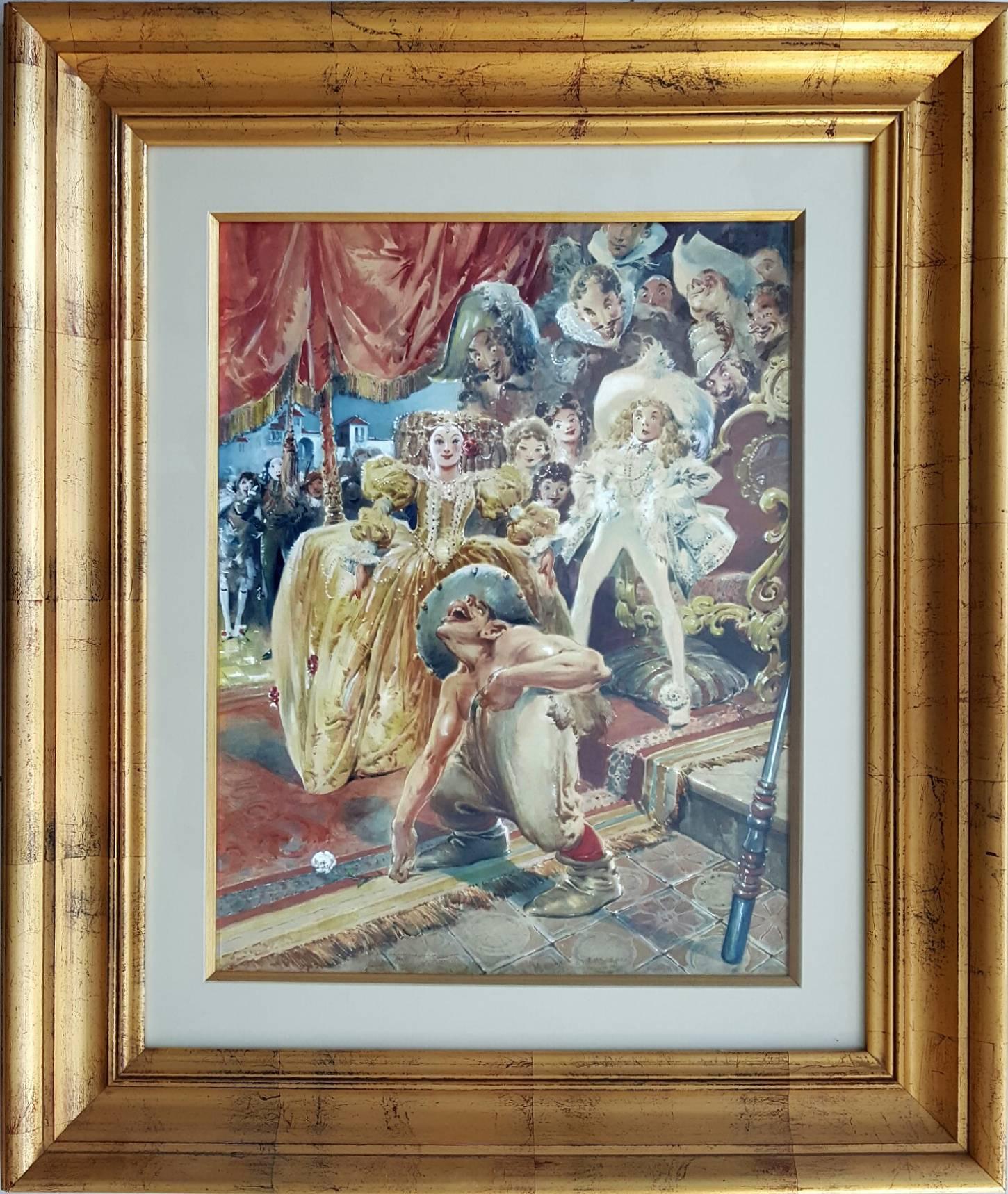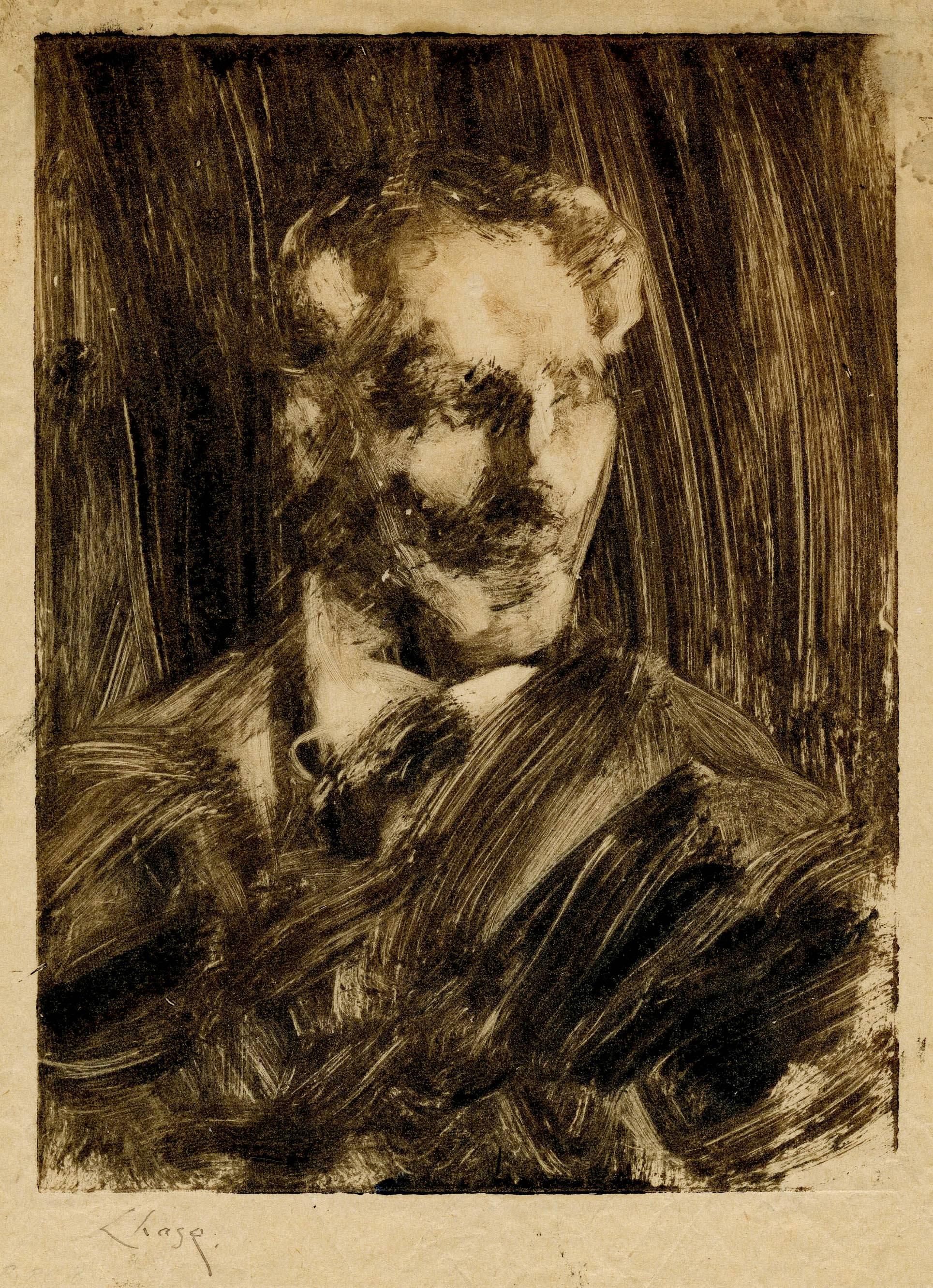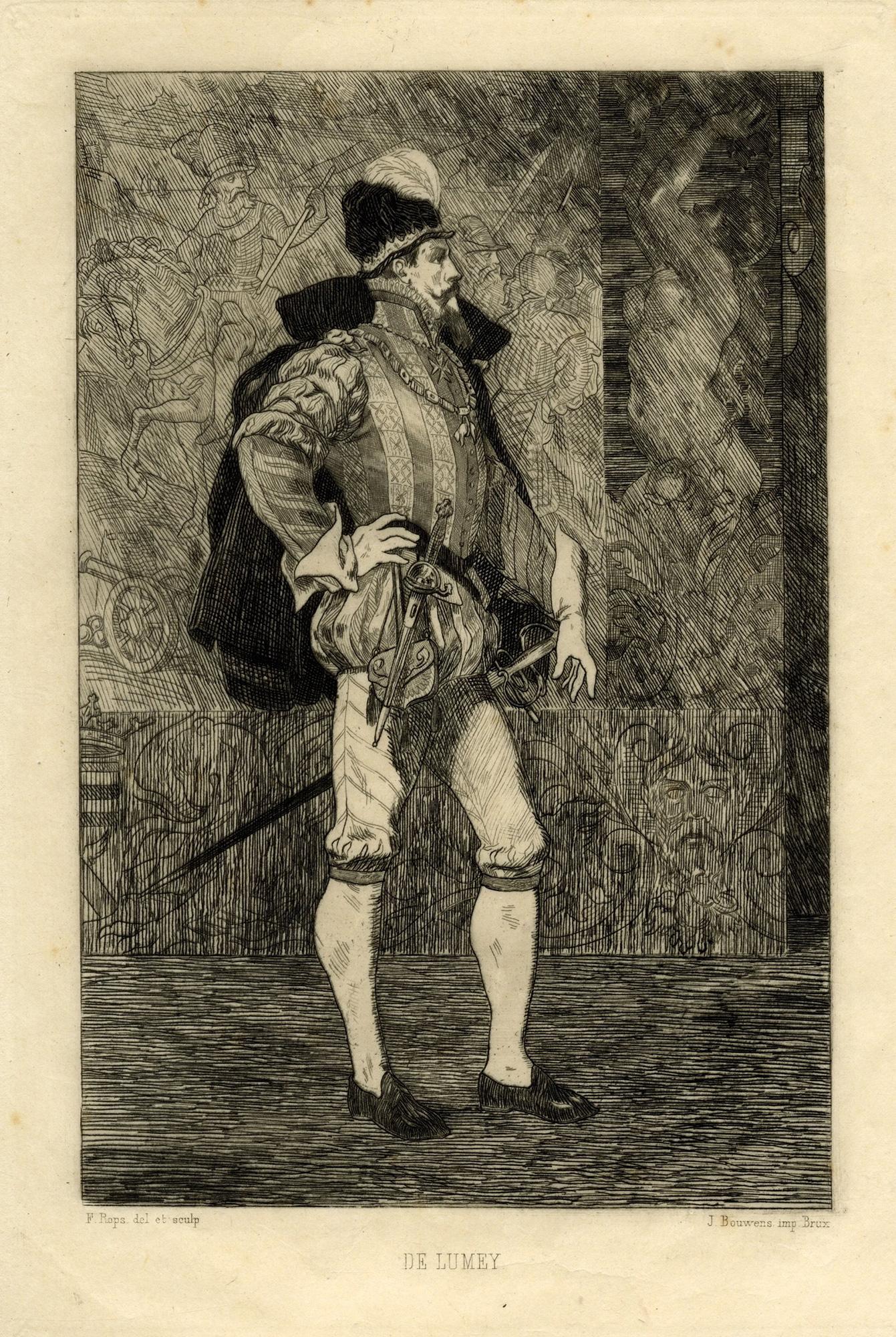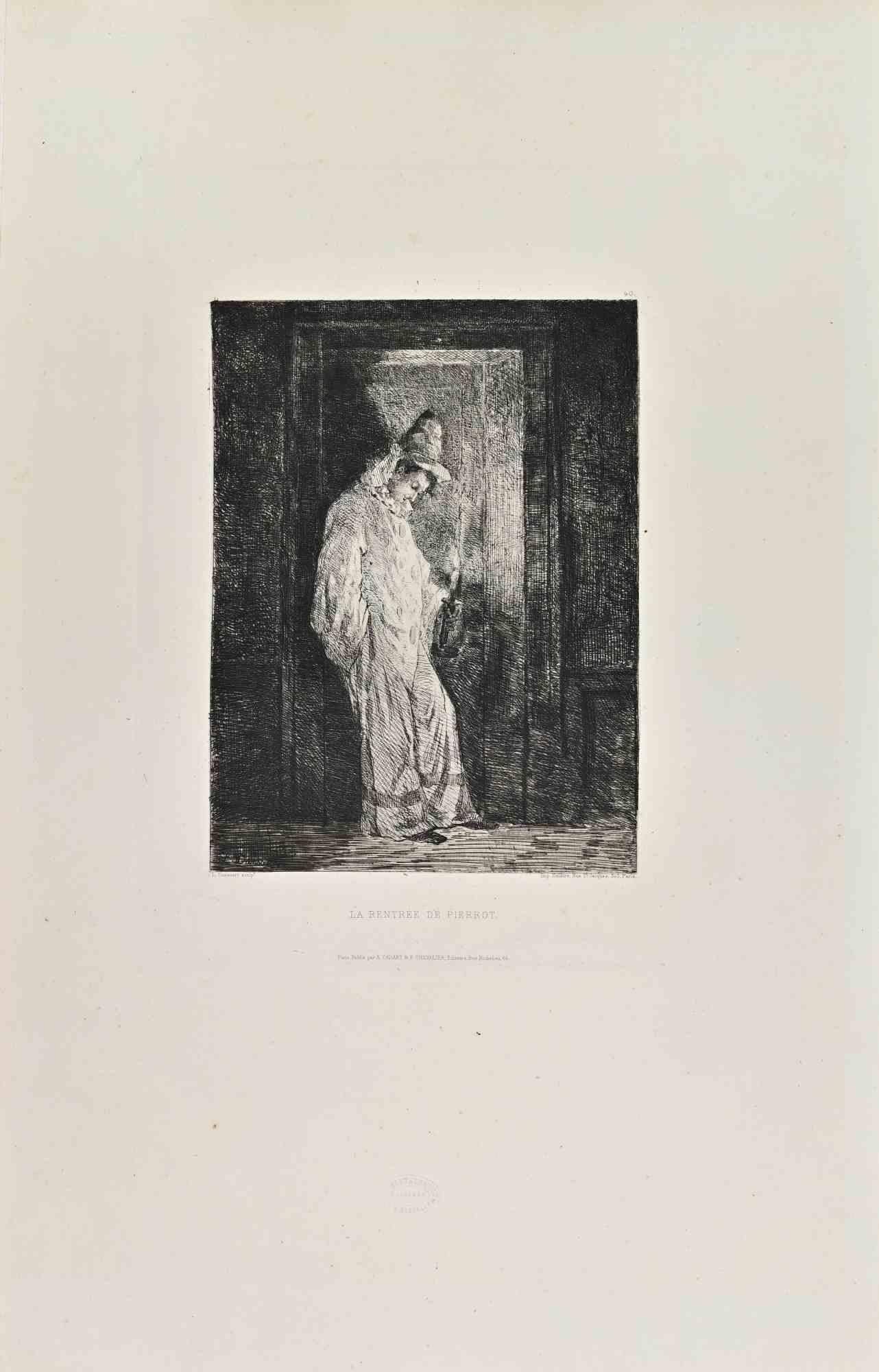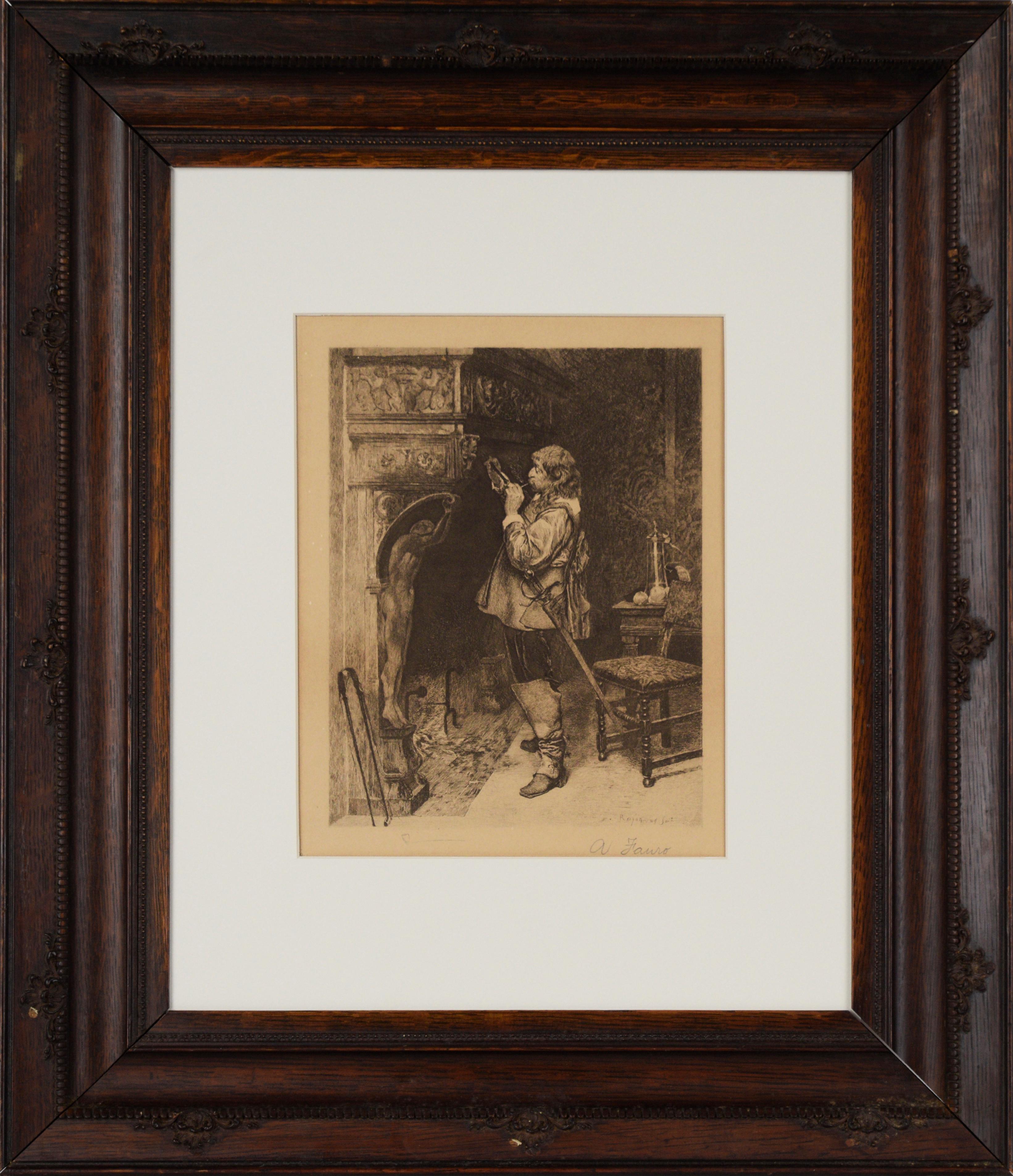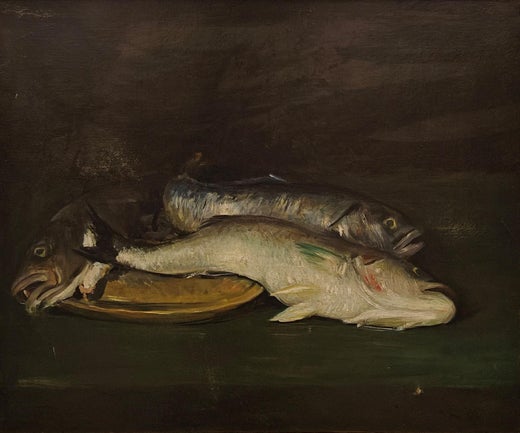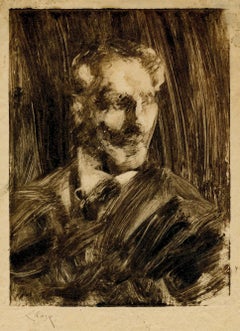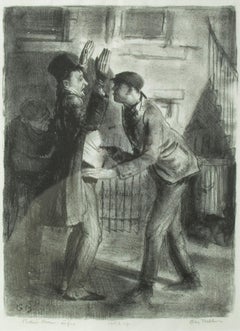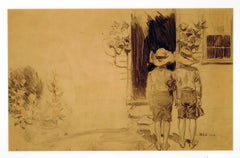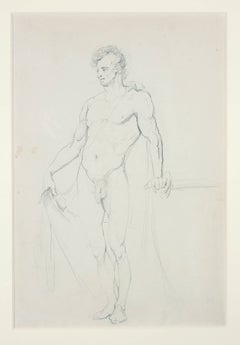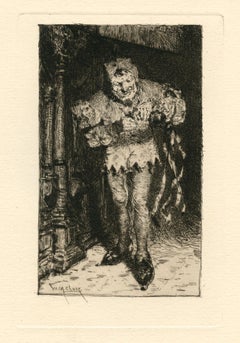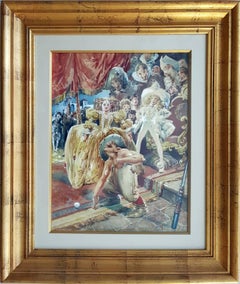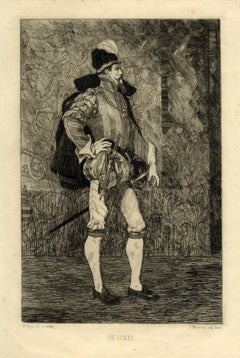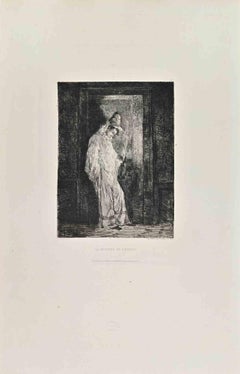Items Similar to Keying Up - The Court Jester
Want more images or videos?
Request additional images or videos from the seller
1 of 10
William Merritt ChaseKeying Up - The Court Jester1879
1879
$1,200
£930.71
€1,054.92
CA$1,717.41
A$1,876.62
CHF 972.90
MX$22,418.90
NOK 12,380.78
SEK 11,591.34
DKK 7,877.30
About the Item
Keying Up - The Court Jester
Etching with drypoint, 1879
Signed in the plate lower left corner (see photos)
Proof before engraved title and engraved names
Printed on thin light golden Japanese tissue paper
In the final state, with engraved titled and typeface engraved artist’s signature below the image
Condition: excellent
Plate size: 6-5/8 x 4-1/4"
According to Pisano, this image was very popular during Chase’s life. It is based on his famous painting, Keying Up-The Court Jester, in the collection of the Pennsylvania Academy of Fine Arts. The painting was created in Munich during the artist’s studies there. It was exhibited in the 1876 Centennial Exhibition in Philadelphia where it won a Medal of Honor and helped establish the artist’s reputation as a leading American painter.
Chase, always conscious of self promotion, created the etching and had numerous impressions printed. He sold them for a modest price to increase his fame. The etching was later published in Sylvester R. Koehler, American Art Review, September 1878. It was for this American Art Review printing that the engraved titled and type face signature below the image were added to the plate.
This example was part of a group of impressions that came down in the Chase family via his daughter Dorothy Bremond Chase, his third daughter. They were acquired at auction in a single auction lot, housed in a paper board folder. The consignor was Associated American Artist’s as they were liquidating their stock prior to closing the gallery.
Dorothy was the subject of Chase’s painting, My Little Daughter Dorothy. C. 1894, in the collection of the Detroit Institute of Arts as well as numerous other portraits of her.
Reference: Pisano/Bake, Volume 1, Pr. 3, illustrates the rare 1st state, this being a 2nd state before any other the engraved title and Chase's name in the bottom margin which are found in the third state.
Artist bio in file (Chase)
In 1883 Chase was involved in the organization of an exhibition to help raise funds for a pedestal for the Statute of Liberty. The exhibition featured loans of three works by Manet and urban scenes by the Italian Impressionist Giuseppe de Nittis. Both artists influenced Chase's Impressionistic style that gave rise to a series of New York park scenes. It is also thought that he was influenced by John Singer Sargent's In the Luxembourg Gardens (1879) which was exhibited in New York at this time. Indeed, Chase had met Sargent in Europe in 1881, the two men becoming lifelong friends with Sargent painting Chase's portrait in 1902.
On another European trip in 1885, Chase met James McNeill Whistler in London. While Whistler had a reputation for being difficult, the two artists got along famously and agreed to paint one another's portrait. Eventually, however, Whistler's moods began to grate with Chase who wrote home stating "I really begin to feel that I never will get away from here". For his part, Whistler criticized Chase's finished portrait and, according to Hirshler, "complained about Chase for the rest of his life". While no record exists of Whistler's portrait of Chase; Chase's portrait of Whistler remains a well-known piece in his oeuvre.
In 1887 Chase married Alice Gerson, the daughter of the manager of a lithography company. Though some fifteen years his junior (Chase was 37), he had known Alice for some time through her family's devotion to the arts. The pair, who would enjoy a happy marriage with Alice in full support of her husband's career, settled initially in Brooklyn where their first child was born. The couple would parent six daughters and two sons and it was only his family that could rival his devotion to his art. Indeed, Chase often combined his two loves by painting several portraits of his wife and children in Brooklyn parks before the couple relocated to Manhattan.
Later Period
Between 1891 and 1902, Chase and his family spent their summers at a purpose-built home and studio in Shinnecock Hills, a close suburb of the upmarket town of Southampton on the south shore of Long Island (roughly 100 miles east of New York). Chase set up, and taught two days a week, at the nearby Shinnecock Hills Summer School of Art which benefitted from the financial backing of local art collectors. It was at Shinnecock that Chase, taken in by the region's striking natural surroundings, painted several Impressionistic landscapes. As Bettis put it, "There, among the dunes, in the bright sunlight and sea air his painterly impulse was given free sway, and he produced some of his freest and loveliest work". His passion for the area was so felt he even gave his daughter Hazel the middle name of Neamaug, in honor of the rich Native American history of Shinnecock. Chase was equally focused on the students that came to the School and who he encouraged to paint in the modern plein air style favored by the French Impressionists.
Although Chase was making a name for himself as an Impressionist, he never abandoned his commitment to the sombre tones and academic tropes he had learned in Munich, though these he reserved for his portraits, and for his series of striking still lifes featuring dead fish. Chase was in fact a successful society portraitist - he painted fashionable women for a fee of $2,000 - and would paint his students as "samples" which he then donated to leading art institutions (such as Lady in Black (1888) which he donated to the Metropolitan Museum in 1891).
In 1896, facing financial difficulties, Chase flirted with the idea of giving up his teaching in New York and traveled with his family to Madrid where he developed a passion for bullfighting. Chase returned however to Shinnecock in June to teach his yearly summer art class, and in the fall of that year, established his own art school in Manhattan: the Chase School which was modelled on the Académie Julian in Paris. Chase lacked business savvy, however, and the Chase School lasted only two years before it was placed under new management. It continued as the New York School of Art (changed to Parsons School of Design starting 1941) with Chase as head the School for eleven more years. Chase also taught during this period at the Pennsylvania Academy of Fine Arts.
In 1902, following the premature death of his friend John Twachtman, Chase was invited to join the Ten American Painters group (who included amongst its members, Frank Weston Benson, Thomas Wilmer Dewing, Robert Reid and Julien Alden Weir) with whom he continued to exhibit for the remainder of his career. Like Chase, the other group members were committed to the philosophy of Eclecticism. As the art historian Isabel L. Taube described it, Eclecticism amounted to more than just a "jumble of sources" and depended rather on "clear intention and reason instead of chance and intuition". She adds that by the late nineteenth century "discussions of eclecticism in popular magazines and trade publications emphasized the difficult and serious study required to achieve a harmony of diverse elements in architecture as well as the fine and decorative arts".
Though he painted and exhibited until his death in 1916, in this later years Chase devoted more and more time to teaching, dividing his time between Europe and America. Between 1902 and 1913 he spent his summers travelling to Europe where he taught classes in Belgium, England, Italy, Holland and Spain. His last European class was held in Venice in the summer of 1913. Chase had also taken great pride in the studio set up he established at Fourth Avenue in 1908. Here he taught private classes while continuing to work enthusiastically on his own paintings. He maintained his association with the Art Students League of New York until 1912 and, in 1914, he experienced a new teaching environment by conducting summer classes on the West Coast in Carmel, California. During the winter of 1916, Chase began to feel unwell. Though he continued to paint, he grew increasingly ill from what was diagnosed as cirrhosis of the liver. Forced to cut short a visit to Atlantic City, Chase returned to New York where he died two days later aged just sixty-six.
The Legacy of William Merritt Chase
Chase had a profound impact on shaping the development of modern art in the United States. As curator Erica Hirshler explains, "Chase developed an American version of Impressionism to depict modern subjects" and started incorporating other modern artmaking techniques in the way he "often employed daringly abstract compositions, devising interlocking patterns of vertical and horizontal lines or dramatic diagonal sweeps that provided a firm geometric foundation for his loose strokes of color". She adds that he "also experimented with different media and was an innovator in the revival of painting in pastel". Indeed, according to the Phillips Collection website, as "co-founder of the progressive Society of American Painters in Pastel, Chase was a leader in the late 19th-century revival of pastel painting and one of its most innovative practitioners".
Chase also created an impressively important legacy as an art teacher. While the notion of plein air painting had been embraced by the French Impressionists, Chase led the way in importing that approach to America; both through the example of his own works but also by encouraging his students to engage in the practice as well. Unlike some instructors who required students to mimic their own methods, Chase chose simply to encourage his students to explore their own artistic paths. As Hirshler explains, "perhaps Chase's success as a teacher is marked by the fact that only some of his students followed his stylistic example; others - among them Lydia Field Emmet, Rockwell Kent, Marsden Hartley, Edward Hopper, Charles Sheeler, and Georgia O'Keeffe - used what they learned in his classes as a springboard for their own artistic innovations". He was also considered a trailblazer in his appreciation of women artists. As author Christina Michelon explains, "Chase's modern thinking extended to [...] his mentoring of female students.
Courtesy of The Art Story
- Creator:William Merritt Chase (1849-1916, American)
- Creation Year:1879
- Dimensions:Height: 6.63 in (16.85 cm)Width: 4.25 in (10.8 cm)
- Medium:
- Movement & Style:
- Period:
- Condition:
- Gallery Location:Fairlawn, OH
- Reference Number:Seller: FA53381stDibs: LU14015204032
William Merritt Chase
William Merritt Chase rejected his father’s shoe business in favor of studying art professionally, training with Barton S. Hayes in Indianapolis and going abroad to the Royal Academy in Munich. His brushwork and use of light was similar to the French Impressionists, and his style of visual modelling was particularly influenced by Eduoard Manet. After he finished his studies Chase travelled to New York City and began teaching as part of the Art Students League, quickly becoming a renowned teacher. He incorporated Impressionist techniques along with his more traditional European education to create unique images imbued with the valued urbanization and expansion of New York City. Later in his life, Chase established the Chase School, which eventually was renamed the Parsons School of Design.
About the Seller
5.0
Recognized Seller
These prestigious sellers are industry leaders and represent the highest echelon for item quality and design.
Gold Seller
Premium sellers maintaining a 4.3+ rating and 24-hour response times
Established in 1978
1stDibs seller since 2013
824 sales on 1stDibs
Typical response time: <1 hour
Associations
International Fine Print Dealers Association
- ShippingRetrieving quote...Shipping from: Fairlawn, OH
- Return Policy
More From This Seller
View AllPortrait of a Man Facing Left
By William Merritt Chase
Located in Fairlawn, OH
Portrait of a Man Facing Left
Monotype printed in brown ink, c. 1880-1914
Signed in ink lower left: Chase (see photo)
Provenance:
Helen Chase Storm (the artist's daughter)
Jackson Chase Storm (her son)
Chapellier Galleries (as agent)
James Bergquist, Boston
References And Exhibitions:
Exhibited at the Museum of Fine Arts, Boston and the Clark Art Institute, Williamstown, MA. (See MFA paperwork in photos)
Reference:
Ronald G. Pisano, Completed by D. Frederick Baker and Carolyn K. Lane, William Merritt Chase: Still Lifes, Interiors, Figures, Copies of Old Masters, and Drawings, Catalogue Raisonne, Vol. IV (New Haven and London: Yale University Press, 2010), Vol. 1, M. 8. (See photos of entry)
William Merritt Chase (1840-2016)
Born in Nineveh, Indiana Died New York, New York
In 1883 Chase was involved in the organization of an exhibition to help raise funds for a pedestal for the Statute of Liberty. The exhibition featured loans of three works by Manet and urban scenes by the Italian Impressionist Giuseppe de Nittis. Both artists influenced Chase's Impressionistic style that gave rise to a series of New York park scenes. It is also thought that he was influenced by John Singer Sargent's In the Luxembourg Gardens (1879) which was exhibited in New York at this time. Indeed, Chase had met Sargent in Europe in 1881, the two men becoming lifelong friends with Sargent painting Chase's portrait in 1902.
On another European trip in 1885, Chase met James McNeill Whistler in London. While Whistler had a reputation for being difficult, the two artists got along famously and agreed to paint one another's portrait. Eventually, however, Whistler's moods began to grate with Chase who wrote home stating "I really begin to feel that I never will get away from here". For his part, Whistler criticized Chase's finished portrait and, according to Hirshler, "complained about Chase for the rest of his life". While no record exists of Whistler's portrait of Chase; Chase's portrait of Whistler remains a well-known piece in his oeuvre.
In 1887 Chase married Alice Gerson, the daughter of the manager of a lithography company. Though some fifteen years his junior (Chase was 37), he had known Alice for some time through her family's devotion to the arts. The pair, who would enjoy a happy marriage with Alice in full support of her husband's career, settled initially in Brooklyn...
Category
1890s Impressionist Portrait Prints
Materials
Monoprint
The Hold Up, First State
By George Wesley Bellows
Located in Fairlawn, OH
Signed in pencil by the artist lower right
Titled "Hold Up" by the artist in pencil.
Signed by the printer Bolton Brown lower left.
Edition: 42 in this state
Note: In The Hold Up, se...
Category
1920s American Realist Figurative Prints
Materials
Lithograph
"And wasn't it good for a boy to be Out to old Aunt Mary's"
By Howard Chandler Christy
Located in Fairlawn, OH
"And wasn't it good for a boy to be Out to old Aunt Mary's"
Charcoal and watercolor on artist illustration board, 1900
Initialed and dated lower right: H.C.C. 1900 by the artist (see...
Category
Early 1900s American Impressionist Figurative Drawings and Watercolors
Materials
Charcoal
Standing Male Nude (recto) Study of the Head of the Standing Male Nude (verso)
By William Merritt Chase
Located in Fairlawn, OH
Standing Male Nude (recto)
Study of the Head of the Standing Male Nude (verso)
Unsigned
Provenance:
Estate of the artist
Helen Chase Storm (the artist's daughter)
Jackson Chase Storm (the artist's grandson)
Baker-Pisano Collection (the author of the William Merritt Chase Catalog Raisonne Project)
References And Exhibitions:
Pisano D8, reproduced p. 183
Rare. Chase did relatively few drawings, probably no more than 150 in total, according to the catalogue raisonne.
William Merritt Chase (1840-2016)
Born in Nineveh, Indiana Died New York, New York
In 1883 Chase was involved in the organization of an exhibition to help raise funds for a pedestal for the Statute of Liberty...
Category
1870s American Impressionist Nude Drawings and Watercolors
Materials
Graphite
Standing Male Nude (recto) Study of the Head of the Standing Male Nude (verso)
By William Merritt Chase
Located in Fairlawn, OH
Standing Male Nude (recto)
Study of the Head of the Standing Male Nude (verso)
Unsigned
Provenance:
Estate of the artist
Helen Chase Storm (the arti...
Category
1870s American Impressionist Nude Drawings and Watercolors
Materials
Graphite
John Phillip Kemble as Hamlet, Act V, Scene I
By Eastman Johnson
Located in Fairlawn, OH
Signed and dated (on back) "January 1845/ J.E.J."
Provenance:
Mr. and Mrs. Bertram Rowland, Buckingham, PA
Mr. and Mrs. Edward Abraham, West Chester, PA
Hirschl & Adler Galleries...
Category
1840s Portrait Drawings and Watercolors
Materials
Charcoal
You May Also Like
"Keying Up - The Court Jester" original etching
By William Merritt Chase
Located in Henderson, NV
Medium: original etching. This impression on laid paper was published by the American Art Review in 1880. The etched image measures 5 3/4 x 3 1/2 inches; the plate measures 6 3/4 x 4...
Category
1880s Portrait Prints
Materials
Etching
Court Jester - Golden Age of Illustration
By Everett Shinn
Located in Miami, FL
Meticulously and carefully rendered period piece that reenact this magicaly moment. Works on Paper, Gouache, Watercolor over traces of pencil heightened with white on illustration ...
Category
1940s American Realist Figurative Drawings and Watercolors
Materials
Watercolor
Le Sire De Lumey
By Félicien Rops
Located in Middletown, NY
Brussels: J. Bouwens, 1867. Etching with aquatint and engraving on laid Japan paper, 9 3/4 x 6 1/2 inches (247 x 163 mm), full margins. Fifth state (of 5). Scattered moderate foxing....
Category
Late 19th Century Symbolist Portrait Prints
Materials
Laid Paper, Engraving, Etching, Aquatint
La Rentree de Pierrot - Etching by Leon Marie Constant Dansaert - 1860s
Located in Roma, IT
La rentree de Pierrot is a black and White etching realized by Leon Marie Constant Dansaert in 1863.
Titled in the lower
Image Size: 32x23
Very good impression.
Ref.
- Maxime L...
Category
1860s Modern Figurative Prints
Materials
Etching
Antique Lithograph Shakespeare's "The Taming Of The Shrew" Character Petruchio
Located in Soquel, CA
"The Smoker" After Shakespeare's "The Taming Of The Shrew" Petruchio - Antique Lithograph
Lithograph titled "The Smoker," after the character ...
Category
Mid-19th Century Tonalist Figurative Prints
Materials
Ink, Laid Paper
Vieille Masken, La Servante Anversoise
By Félicien Rops
Located in Middletown, NY
Etching with engraving and drypoint printed in brownish black ink on cream laid paper with a partial heraldic A and fleur-de-lis watermark, 5 5/8 x 4 1/4 inches ( 341 x 107 mm), full...
Category
Late 19th Century French School Portrait Prints
Materials
Laid Paper, Engraving, Drypoint, Etching
More Ways To Browse
Antique Keys
Antique French Keys
Robert Thomas
The Jester
Antique Jester
Court Jester
Liberty Loan
Antique Court Jester
Frank Thomas
Max Beckmann Drypoint
May Belfort
Melanie Taylor Kent
Mexican Revolution Art
Michel Delacroix On Sale
Munch Poster 1969
Naoko Matsubara
Nude At The Window Dali
Nursery Rhyme Prints Vintage
